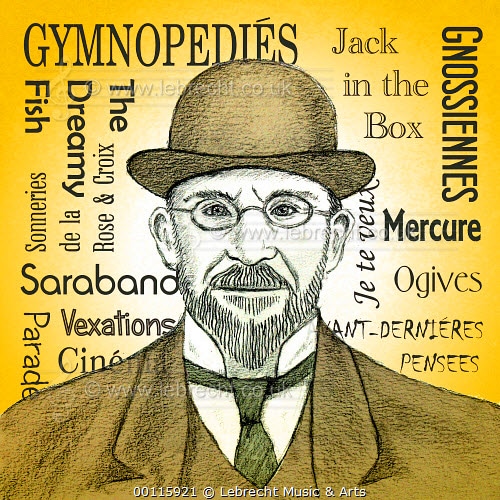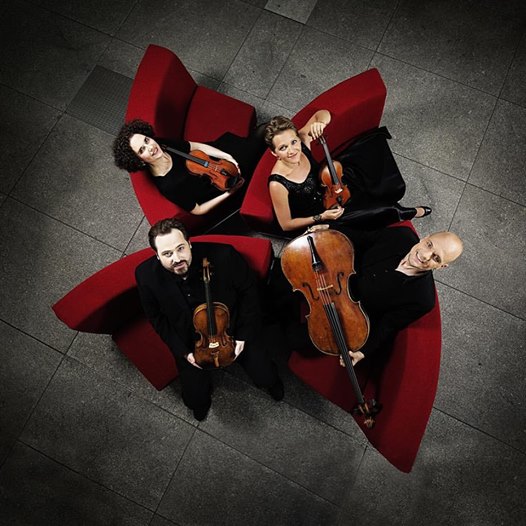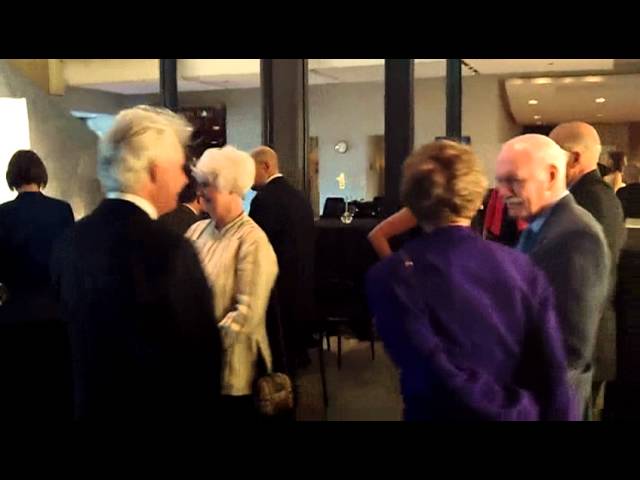A very French, rather short, documentary for the 150th anniversary of the composer of Véxations.

A very French, rather short, documentary for the 150th anniversary of the composer of Véxations.

Notice from the League of American Orchestras:
UPDATED JULY 8, 2016
New Ivory Rules Support Musical Instruments
On July 6, 2016, new rules took effect related to both international travel and domestic commerce with musical instruments that contain small quantities of African elephant ivory. The League played a key leadership role in national conversations with White House officials, top leadership at U.S. Fish and Wildlife Service (USFWS), Congress, and conservation organizations to successfully seek solutions that would address urgent conservation concerns while also protecting international cultural activity.
The rules broaden access to travel permits, allow for domestic interstate commerce in musical instruments containing small quantities of ivory, and very helpfully clarify that legally-crafted musical instruments are not contributing to the African elephant poaching and trafficking crisis.
In announcing the rules to reverse current travel restrictions and provide opportunities for ongoing domestic interstate commerce in musical instruments, the USFWS stated that, “We listened carefully to the legitimate concerns raised by various stakeholder groups and, as a result, are allowing commonsense, narrow exceptions for musicians, musical instrument makers and dealers…to trade items that have minimal amounts of ivory and satisfy other conditions. These items are not drivers of elephant poaching and do not provide cover for traffickers.”
Here are highlights of the new ivory rules, as they relate to musical instruments. Note that the new rules for African elephant ivory are distinct from those for Asian elephant ivory, which is under a higher level of protection. The first step for musicians is to verify the type of ivory in their instruments. Further detail is also available in an extensive USFWS guide, “What Can I do with My Ivory.”
For the requirement that the instrument be “securely marked” or “uniquely identified,” USFWS explains in the rules that “a photograph may be used to identify an item, in place of a mark, as long as the photograph allows a border official to verify that the certificate and the item correspond.”
Further requests of the music community related to easing international travel restrictions will be under consideration in separate U.S. rulemaking procedures, and as CITES is renegotiated in 2016.
- If the item is located within the United States, the ivory must have been imported into the United States prior to January 18, 1990, or was imported into the United States under a Convention on International Trade in Endangered Species of Wild Fauna and Flora (CITES) pre-Convention certificate with no limitation on its commercial use;
- If the item is located outside the United States, the ivory must have been removed from the wild prior to February 26, 1976;
- The ivory is a fixed or integral component or components of a larger manufactured or handcrafted item (e.g. tuning pegs) and is not in its current form the primary source of the value of the overall item, that is, the ivory does not account for more than 50 percent of the value of the item;
- The ivory is not raw;
- The manufactured or handcrafted item is not made wholly or primarily of ivory, that is, the ivory component or components do not account for more than 50 percent of the item by volume;
- The total weight of the ivory component or components is less than 200 grams; and
- The item was manufactured or handcrafted before July 6, 2016.
200-gram Limit
Among the variety of musical instruments that have been previously made with small quantities of African elephant ivory, the most common are bows used for stringed instruments, which may have a piece of finished ivory on the protective tip. The quantity of ivory in a bow tip weighs on average 0.25 grams. Embellishments on bassoons and stringed instruments, and the veneer of piano keys use larger quantities and many are expected to fall within this limit. Some bagpipes and instruments with multiple keyboards, however, may fall outside this 200-gram threshold.
The rules clarify that they are specific to African elephant ivory, and do not apply to mammoth ivory or other species.
The rules also state, “We will not require ivory components to be removed from an item to be weighed.”
The USFWS has produced a photo gallery on how to help estimate the size of ivory content weighing less than 200 grams. Their Q & A on the final rules offers the following illustration:
“When we proposed the 200-gram limit we had a particular suite of items in mind. The following types of items may qualify for the de minimis exception: many musical instruments (including many keyboard instruments, with ivory keys, most stringed instruments and bows with ivory parts or decorations, and many bagpipes, bassoons and other wind instruments with ivory trim)… A piece of ivory that weighs 200 grams is slightly larger than a cue ball. The 200-gram limit is large enough to accommodate the white key veneers on an 88-key piano.”
Value of Ivory
The rules clarify how to know whether an item meets the requirements for establishing that the ivory is not the primary source of the item’s value:
“Value can be ascertained by comparing a similar item that does not contain ivory to one that does (for example, comparing the price of a basket with ivory trim/decoration to the price of a similar basket without ivory components). Though not required, a qualified appraisal or another method of documenting the value of the item and the relative value of the ivory component, including, as noted above, information in catalogs, price lists, and other similar materials, can also be used.”
Fixed or Integral Components
The final rules helpfully clarify that parts that are integral to a musical instrument, but are not “fixed” to it will meet the de minimis requirements:
“We added the words “or integral” to the criterion in paragraph (e)(3) that describes the ivory being a fixed component of a larger manufactured or handcrafted item to cover items that have small ivory pieces that can be easily removed (like nuts or pegs on some wooden tools or instruments).”
Documentation Requirements
The USFWS makes the following clarification regarding documentation requirements for commerce:
“If you wish to sell your African elephant ivory item across state lines (interstate commerce), you will need to be able to demonstrate that your ivory either qualifies as an ESA antique or meets the de minimis criteria.
You may sell your African elephant ivory items within a state (intrastate commerce) if you can demonstrate that your ivory was lawfully imported prior to the date that the species was listed in CITES Appendix I (January 18, 1990 for the African elephant). This proof could be in the form of a CITES pre-Convention certificate, a datable photo, a dated letter or other document referring to the item.
You do not need to apply for a permit or contact our office to conduct intrastate or interstate commerce with elephant ivory; however, you should have all documentation available to demonstrate the legality of the sale, if asked. We would also suggest that you provide all documentation to the buyer of your elephant ivory items.
Check to make sure that you are also in compliance with local and state laws. Contact the state to check on their requirements.”
For antiques, USFWS says the following about confirming that an item is more than 100 years in age:
“We want to clarify that forensic testing is not necessarily required. Provenance and age may be determined through a detailed history of the item, including but not limited to, family photos, ethnographic fieldwork, art history publications, or other information that authenticates the article and assigns the work to a known period of time or, where possible, to a known artist or craftsman. A qualified appraisal or another method, including using information in catalogs, price lists, and other similar materials that document the age by establishing the origin of the item, can also be used.”
In extensive non-regulatory guidance, USFWS says the following:
“To determine the appropriate legal framework for your elephant ivory, you first need to determine whether your items are made of African or Asian elephant ivory. Such proof can be in the form of a qualified appraisal or other documentation that demonstrates the identification of the species through a detailed provenance of the article.”
Repairs
The preamble to the final rule clarifies, “We believe that taking an article across State lines for repair, for example, rightfully falls outside what is considered ‘commercial activity.’”
Enforcement
The rules include the following important clarification about the enforcement priorities related to the new rules:
“Our law enforcement focus under this rule will be to help eliminate elephant poaching by targeting persons engaged in or facilitating illegal ivory trade. While it is the responsibility of each citizen to understand and comply with the law, and that is our expectation with regard to this regulation, we do not foresee taking enforcement action against a person who has exercised due care and reasonably determined, in good faith, that an article complies with the de minimis requirements.”
Example scenarios:
The Q & A also offers the following example of how the rules would apply to musical instruments:
“I have a violin bow that contains a small amount of ivory. Under the proposed revisions, will I be able to sell the bow in the United States, export it for sale, or take it overseas for a concert?
If the bow meets the requirements for the de minimis exception, including that the ivory was removed from the wild prior to February 26, 1976, and that the total weight of the ivory is less than 200 grams you will be able to sell it in the United States.
If the bow qualifies as an ESA antique you will be able to export it for sale.
If the bow meets the requirements for import/export of a musical instrument, including that the ivory was removed from the wild prior to February 26, 1976, it is accompanied by a CITES musical instrument certificate or equivalent CITES document, the bow is securely marked or uniquely identified, and it will not be sold or otherwise transferred while outside the United States (see paragraph (e)(4) in the proposed rule text for details) you can travel with it internationally for personal use, including to perform in concert.”
Next Steps
The music community is fully committed to the goals of wildlife conservation and combating illegal trade in ivory and other protected species. The new rules present reasonable solutions that protect the domestic and international use of musicians’ tools of their trade, and preserve the use of historically and legally made instruments now and for future generations to come. The League is in ongoing dialogue with the Administration and key policy leaders to seek further solutions that address wildlife conservation goals while also protecting international musical activity that requires musicians to travel across borders with the tools of their trade.
The League is grateful to our partners at Chamber Music America, The Recording Academy, the American Federation of Violin and Bowmakers, NAMM, the American Federation of Musicians, Carnegie Hall, and our other national partners coordinating efforts to make progress on this complex policy issue.
Background
Following an Obama Administration effort to protect African elephants from poaching by combating illegal trade in ivory, the director of the U.S. Fish and Wildlife Service (USFWS) ordered strict enforcement procedures related to the Endangered Species Act and the African Elephant Conservation Act on February 25, 2014. According to this order, many instruments containing African elephant ivory would not be allowed into the U.S., even if a musician were simply returning to the U.S. with instruments in their personal possession, not intended for sale. The original order prevented travel into the U.S. with instruments containing ivory that had been purchased since February 26, 1976. A great many musical instruments containing African elephant ivory, while legally manufactured and acquired, have been purchased after 1976, and would have been completely prohibited from entering into the U.S. It is not uncommon for professional orchestra musicians, particularly string players, to perform with instruments that contain small amounts of ivory, most frequently found in the tips of bows. African elephant ivory can also be found in an array of older string, wind, and percussion instruments; however, there is no longer a demand for using elephant ivory to create new instruments.
In response to urgent appeals from the League and other national stakeholders, U.S. Fish and Wildlife agreed to ease the restrictions on musical instruments. Director’s Order 210 was amended on May 15, 2014 to allow travel with instruments purchased prior to February 25, 2014 that contain African elephant ivory.
As the Administration prepared to finalize rules related to a broad African elephant ivory ban, the League advanced the following requests:

Terry Teachout thinks they are.
The drama critic bangs the drum in the Wall Street Journal on their behalf, citing as evidence that ‘Some quick research shows that Harris, Mennin, Piston, Schuman and Elliott Carter (who together wrote more than 100 concert symphonic works) had, in the past five years, a total of just 20 performances by U.S. orchestras.’
That, you might say, is a first world problem. If US orchs don’t think their own composers will fill a hall, why should anyone else imagine that they are worth performing?
But there’s more to the problem than hardcore capitalist economics.
There is a measure of resistance in some quarters to US symphonic music and it has been embedded for quite a while. In a culture swamped by American movies, pop music, fashion and art, some European and American aesthetes try to preserve the concert hall – perhaps unfairly – as a US-free zone.
Tough on US composers, but there you are.

Next year, however, when Steve Reich and Philip Glass turn 80 we will be inundated with their works.
From the Lebrecht Album of the Week:
There used to be a truth, universally acknowledged across the record industry, that you could put out unfamiliar music with a famous artist or popular music with an unheralded performer but never attempt what Donald Rumsfeld might have called “the unknown unknowns”.
That fundamental truth was well and truly overturned by the rise of Naxos, which built its fortune on a catholic blend of neglected artists and untapped catalogue, often with salutary results. The present release is a case in point.
Read on here.
And here.

Anyone recognise her?
The Irish conductor and games composer Eimear Noone is suing Jason Michael Paul Productions Inc. in the Los Angeles Superior Court for firing her from the production of “The Legend of Zelda: Symphony of the Goddesses.”
Eimar is claiming pregnancy discrimination and is seeking damages for the depression she suffered after dismissal.
Report here.

The Artemis Quartet got together this week, breaking into their holidays to catch up on a photo session…. and work out how much they need to rehearse before every repeated concert on tour. Two hours, apparently. Our diarist Anthea Kreston takes us into the nitty-gritty of quartet conversation.

Our two weeks in the Italian Dolomites at the Music Academy International wraps up tonight with an outdoor concert at the town square, with students and faculty playing together. I am on a flight from Geneva to Venice – I had to leave for two days to play concerts in Berlin and Geneva with the Artemis. Tomorrow Jason and I have the pleasure of introducing the girls to Venice for the first time – three days in a VRBO and exploring!
It was fantastic to have family time these last 14 days, and it made getting together with the Quartet for our two concerts that much sweeter. We met in Berlin at our regular rehearsal space – some of us tan, some of us with shorts on for the first time. Real summer is here. Our Berlin concert was a blast – a combination of BargeMusic and Le Poisson Rouge. Set directly on the Spree River (on the boundary between old East and West Berlin) on an open barge stage. The audience was spread between three boats that came from different ports throughout Berlin, moored to the barge, an audience barge between the concert stage and club, and several floors of the techno night club on the pier, the wall of windows open to the river. Drinks were flowing, and the mixed audience (tickets were hand stamps) was interactive and energetic. The beautiful brick bridge also sported crowds of audience, getting free tickets by cramming into the pedestrian arches. I felt like a rock star.
Yesterday we went to Geneva for the final summer concert until late August. I had a chance to take a long walk through the city – something I try to do any chance I get. I know that I will come back to most of these cities again, and what a pleasure to be able to travel so widely as a member of this quartet. Quite spectacular.
Last night at the post-concert dinner, we were talking about this past 5 months. 37 concerts under our belts, and now we will not meet again until the end of August. We talked about a lot of things, including basic repertoire organization. The Artemis likes to play three concerts of repertoire each season (9 pieces) plus 3 “jokers” (other repertoire that the presenters can mix and match). There are also the standard add-ons – some viola, cello and piano quintets. I love that we have the chance to really grow with this repertoire – it is a rare treat to be in a group which has total control over their concert programs. Often, in the States, it is required to have “Theme” programs – named programs with something that ties a program together (often loosely) in order to attract audience and to market more easily. But, the Artemis is a theme unto itself – it can pick repertoire solely for artistic purposes, and this allows us to rehearse deeply, and to perform the repertoire many times. The freedom on stage is incredible.
The only potential drawback is the possibility of losing inspiration. When we played in Schwartzenberg the other week, I decided to play the entire concert (which is essentially memorized by this point) only looking at the people who I normally never look at during that particular moment. It was a lot of fun, and I was surprised at how much was going on that I had not been paying attention to.
Backstage, yesterday before our final concert of the season, I asked everyone if they ever have trouble with inspiration. (By now, the quartet can tell when I am gearing up to write a Diary entry, because I start to ask specific quartet questions.) Especially Ecki – he has been in the Artemis for 27 years, and has played these pieces countless times. But – he (and also Vinny and Grischa) is always fresh, always finds his inspiration, clearly enjoying the moments – always with a surprise color or sweep of the phrase.
We talked about the natural flow – the first concerts on new repertoire we are all focused, messing up a little bit, nerves raw. Then we hit the beginning of a flow, then the sweet spot – around concert 15. But after that – this is tricky. It is an easy tendency at this point to start to exaggerate your characters, your dynamics, even your facial expressions. Then, after these couple of concerts, total comfort. Fantastic. I love how this quartet allows and encourages individuality. I sometimes play with my eyes closed, and I remember back in my old quartet days, how this would be a major point of contention. It was not something I planned or intended – it is hard to control. It signifies inner joy and transcendence, and it is such a pleasure to look around the Artemis and to see one, and then the other, close their eyes and relinquish themselves to the music, to the moment.
One thing that I think really keeps this quartet fully engaged and mutually inspiring is that they rehearse before every concert for 1.5-2 hours. This, in my experience, is unusual for a group which plays so many concerts. And the rehearsals are intense. For example, yesterday we played Mozart 387, Janacek 1 and Beethoven 59 #1, all of which we have played around 20 times. We started at the end of the Janacek, building intonation very slowly first with the lower strings, then adding upper strings. We worked in detail backwards through the piece – balance, intonation, passages were played with metronome, and we even reworked who would lead certain measures and changed timings. Some of the members of the group write in the decisions, dating them in the margins, so we have a clear map of what we have decided and when.
Then we went to the Beethoven – again backwards. Intonation on the final Presto, changing the length of the quarter notes in the final 3 bars (long, wait – longer longer). Then, after working backwards, we arrive at the first movement. That section between the first and second theme, where we are homo-rhythmic. We just were not together in the 6th bar of that. We stopped and I said “I am so annoyed at myself. Why aren’t I with anyone?” We have never really been good at those two beats. So – we tried a new bowing, suggested by the cellist. A strange idea to play three down bows in a row, the final one a long bow which lasts for a measure and a half. Funny – strange, but somehow it works. And – in the concert – a little twinkle of the eye as we get to that measure – we finally got it! After 5 months!
Then to the Mozart. We talk a little about what the audience reaction has been to each piece, and decide to try the Mozart with more lightness and air throughout tonight. And new ideas in the Minuet and Trio – there is something that happens 6 times, and we decide to take time two times, not two times, and leave two up in the air. And – after the concert – the presenter says “your Mozart was exquisite – transparent and like lace”. Great!
So – this is how we stay inspired. As we shared a final toast to our first 5 months, and a round of quartet hugs, we all bid farewell for the next 5 weeks.

Prosecutors in Fort Worth, Texas, say that they will not demand the death penalty for Sofya Tsygankova if she is found guilty of culpable homicide in the deaths of her two children four months ago.
Tsygankova, 32, has pleaded not guilty to the charges. The estranged wife of Cliburn winning pianist Vadym Kholodenko, she is being held in jail, unable to raise a $2 million bond.

Lois Fees played violin in the Oklahoma City Philharmonic from 1951 to her death this week, aged 82.
The orchestra changed names three times during her service and music directors six times.
Lois joins the definitive list of long-serving players at number 5.

Our colleagues at Resmusica report the cancellation of the Nice Jazz Festival, following the July 14 terror attack that took 84 lives.
The festival was due to run July 16-20 with Youssou N’Dour, Melody Gardot and Laura Mvula as headline artists.
Three days of national mourning are being observed.
Music won’t make it better.

Péter Esterházy died yesterday of pancreatic cancer at the age of 66.
The most renowned of Hungarian literary authors, his breakthrough novel Celestial Harmonies traced his family’s fortunes from the days when Haydn worked on their estate to the post-Communist era.
Péter Esterházy showed little interest in contemporary music – with one exception. He wrote an oratorio, Halleluja – Oratorium balbulum, with Péter Eötvös, five years ago. It will be premiered at the end of this month in Salzburg by Daniel Harding and the Vienna Philharmonic.
Eötvös says: ‘Péter Esterházy, proved to be a true prophet when he wrote these lines in 2011: “We need borders. We put up fences everywhere; we even fence within the fences. We’re on the inside, but outside… well, that’s not us. […] Perhaps for the first time, we now have nothing to say about the future.”‘

In an age of $25 million bequests, $400,000 is but a drop in the ocean.
So Marjorie Fisher had to think hard how to make her bequest matter.
Marjorie loved going to hear her local orchestra, the Detroit Symphony. So when writing her will she inscribed a gift of $5,000 to each and every one of its current 78 players.
The news was given to the orch by her son, Phillip Fisher, chairman emeritus of the DSO board.
The Fisher family had been major donors all their lives to the orchestra, which inhabits the Max M. and Marjorie S. Fisher Music Center (pictured).
But this comparatively modest last gesture is in many ways the most touching.
More here.
